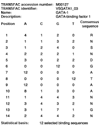Of mice and men: phylogenetic footprinting aids the discovery of regulatory elements
- PMID: 12814519
- PMCID: PMC193683
- DOI: 10.1186/1475-4924-2-11
Of mice and men: phylogenetic footprinting aids the discovery of regulatory elements
Abstract
Phylogenetic footprinting is an approach to finding functionally important sequences in the genome that relies on detecting their high degrees of conservation across different species. A new study shows how much it improves the prediction of gene-regulatory elements in the human genome.
Figures


Similar articles
-
Identifying cis-regulatory elements by statistical analysis and phylogenetic footprinting and analyzing their coexistence and related gene ontology.Physiol Genomics. 2007 Nov 14;31(3):374-84. doi: 10.1152/physiolgenomics.00085.2006. Epub 2007 Sep 11. Physiol Genomics. 2007. PMID: 17848606
-
Phylogenetic footprinting reveals extensive conservation of Sonic Hedgehog (SHH) regulatory elements.Genomics. 2004 Sep;84(3):511-23. doi: 10.1016/j.ygeno.2004.05.009. Genomics. 2004. PMID: 15498458
-
Computational prediction of conserved operons and phylogenetic footprinting of transcription regulatory elements in the metal-reducing bacterial family Geobacteraceae.J Theor Biol. 2004 Sep 7;230(1):133-44. doi: 10.1016/j.jtbi.2004.04.022. J Theor Biol. 2004. PMID: 15276006
-
Phylogenetic footprinting: a boost for microbial regulatory genomics.Protoplasma. 2012 Oct;249(4):901-7. doi: 10.1007/s00709-011-0351-9. Epub 2011 Nov 24. Protoplasma. 2012. PMID: 22113593 Review.
-
Searching for regulatory elements in human noncoding sequences.Curr Opin Struct Biol. 1997 Jun;7(3):399-406. doi: 10.1016/s0959-440x(97)80058-9. Curr Opin Struct Biol. 1997. PMID: 9204283 Review.
Cited by
-
An Exploration Into Improving DNA Motif Inference by Looking for Highly Conserved Core Regions.IEEE Symp Comput Intell Bioinforma Comput Biol Proc. 2013 Apr;2013:60-67. doi: 10.1109/CIBCB.2013.6595389. Epub 2013 Sep 12. IEEE Symp Comput Intell Bioinforma Comput Biol Proc. 2013. PMID: 31008453 Free PMC article.
-
Sequence conservation and functional constraint on intergenic spacers in reduced genomes of the obligate symbiont Buchnera.PLoS Genet. 2011 Sep;7(9):e1002252. doi: 10.1371/journal.pgen.1002252. Epub 2011 Sep 1. PLoS Genet. 2011. PMID: 21912528 Free PMC article.
-
A tandem sequence motif acts as a distance-dependent enhancer in a set of genes involved in translation by binding the proteins NonO and SFPQ.BMC Genomics. 2011 Dec 20;12:624. doi: 10.1186/1471-2164-12-624. BMC Genomics. 2011. PMID: 22185324 Free PMC article.
-
Identification of DNA-binding protein target sequences by physical effective energy functions: free energy analysis of lambda repressor-DNA complexes.BMC Struct Biol. 2007 Sep 27;7:61. doi: 10.1186/1472-6807-7-61. BMC Struct Biol. 2007. PMID: 17900341 Free PMC article.
-
Divergent evolution of human p53 binding sites: cell cycle versus apoptosis.PLoS Genet. 2007 Jul;3(7):e127. doi: 10.1371/journal.pgen.0030127. Epub 2007 Jun 15. PLoS Genet. 2007. PMID: 17677004 Free PMC article.
References
Publication types
MeSH terms
LinkOut - more resources
Full Text Sources

